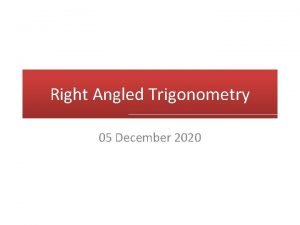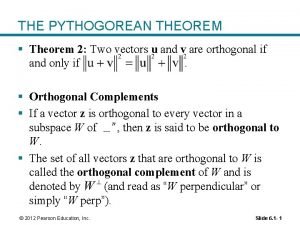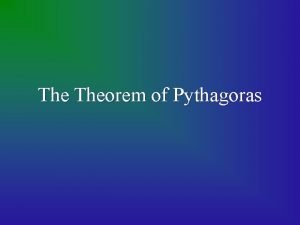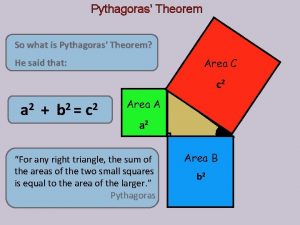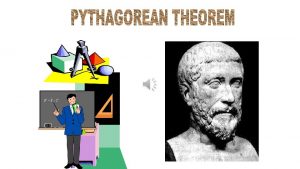Pythagoras Theorem Pythagorean Theorem Over 2 500 years








- Slides: 8

Pythagoras Theorem

Pythagorean Theorem Over 2, 500 years ago, a Greek mathematician named Pythagoras developed a proof that the relationship between the hypotenuse and the legs is true for all right triangles. In any right triangle, the square of the length of the hypotenuse is equal to the sum of the squares of the lengths of the legs. " This relationship can be stated as: and is known as the Pythagorean Theorem a, b are legs. c is the hypotenuse (across from the right angle). There are certain sets of numbers that have a very special property. Not only do these numbers satisfy the Pythagorean Theorem, but any multiples of these numbers also satisfy the Pythagorean Theorem For example: the numbers 3, 4, and 5 satisfy the Pythagorean Theorem. If you multiply all three numbers by 2 (6, 8, and 10), these new numbers ALSO satisfy the Pythagorean theorem.

Example 1. Find the length of AC. A Hypotenuse 16 B Solution : AC 2 AC = = 122 + 144 + 400 20 12 C 162 (Pythagoras’ Theorem) 256

Example 2. Find the length of diagonal d. P Q Solution: d 2 = 102 + 242 (Pythagoras’ Theorem) 24 d S 10 R

Application of Pythagoras’ Theorem 1. A car travels 16 km from east to west. Then it turns left and travels a further 12 km. Find the displacement between the starting point and the destination point of the car. 16 km N 12 km ?

Solution : In the figure, AB = 16 BC = 12 16 km B A 12 km C AC 2 = AB 2 + BC 2 (Pythagoras’ Theorem) AC 2 = 162 + 122 AC 2 = 400 AC = 20 The displacement between the starting point and the destination point of the car is 20 km

2. The height of a tree is 5 m. The distance between the top of it and the tip of its shadow is 13 m. Find the length of the shadow L. Solution: 132 = 52 + L 2 (Pythagoras’ Theorem) L 2 = 132 - 52 L 2 = 144 L = 12 13 m L 5 m

Thank you





